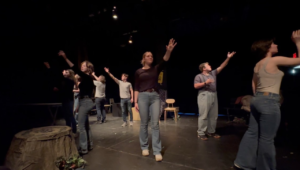In-mid Sentence: The Exhibition of Loud Photographs

Image courtesy of National Portrait Gallery, Smithsonian Institution
By Francesca Faccani
Photography is not a silent medium. Some photographs have the magic -“synesthetic”- ability of speaking loud and clear to who’s watching. An exhibition named “In Mid-Sentence” at the Smithsonian’s National Portrait Gallery brings together some of the most expressive pictures among the museum’s collection.
An excerpt on the wall reads: “Photographs are inherently silent, yet many resonate with unheard voices”. The title, “In Mid-Sentence”, describes the act of a photograph catching a frame of discourse in the moment of its utterance. Featuring about 25 photographs, these pictures are significant in so far as they depict conversations which represent key moments in the history of the United States. For instance, visitors can find the illustrious image of Martin Luther King Jr. holding the “I Have a Dream” discourse. Additionally, an intimate conversation between President John F. Kennedy with Dwight D. Eisenhower a couple of days after the failed “Bay of Pigs” invasion of Cuba can be seen. Visitors can also find Angela Davis mid speech, talking about her time in the Black Panther Party. The aim of the exposition is to explore the power of visual communication by confronting the apparent silence of the images with the loud resonance that these moments have on our historical knowledge.
We must bear in mind that, after all, the National Portrait Gallery is most famous for its presidential portraits, so the exhibition, to some extent, has to follow the trend.
However, political- and particularly presidential- discourse is not the only force to shape a nation’s cultural ethos. Any kind of verbal exchange can be equally pivotal: so intimate confessions, confrontations, and friendly jokes become bearers of a higher message: history. For this very reason, the exhibition is divided into four sections: “public/private”, “just between us”, “in the public eye”, “teaching and learning”.
Institutional political culture is mixed with popular culture (as represented by a picture of Jackie Robinson during a phone call and one of Muhammad Ali during a press conference) and the two don’t clash at all. In its whole, the exhibit conveys a sense of the American culture as “un système où tout se tient”.
The exhibition is an enriching experience and it is definitely worth visiting. The limited quantity of the displayed photographs is justified by the attention put in every detail. Every picture that is presented is accompanied by a placard that carefully sums up the sentence that’s being uttered. Moreover, the choice of only black and white pictures is impactful as they resonate more vividly in our historical memory.
If the intention – as stated in the exhibition’s manifesto – is to “delve deeper into the relationships between the spoken and the written, the public and the private, and the explicit and the implied”, it is successful. Visitors are invited to a deeper reflection on the meaning behind the pictures and on their impact on our culture.
Ultimately, photography is a medium tied to time, not only in its mechanical functioning, but also because it is a pivotal witness of history. This exhibit is the presentation of history through iconic moments that were captured by these photographs. This impactful exhibit opened in March 2019 and will continue to be available to the public until March of 2020.







